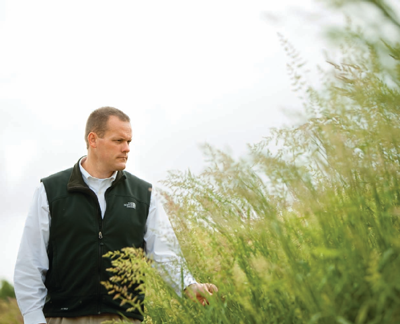Cornell's bioenergy plan gains steam
Cornell's bioenergy plan gains steam
From a knoll on the eastern slope of Mount Pleasant, Drew Lewis can see more than four miles over hill and dale to Cornell's organic research farm. A few promotions ago, the director of agricultural operations for Cornell's Ithaca-based Agricultural Experiment Station often ran a tractor for the better part of a day—and the spot where he's brought his vehicle to rest on this pristine April afternoon was always his favorite among the University's nearly 10,000 acres of New York State field and forest. Bluebirds wheel above bending perennial grasses, a turkey struts through the adjoining wood-lot, and nearby winter wheat sprouts already stand several inches tall.
Today, this pastoral setting is the last stop on Lewis's inspection of a half-dozen venues—including a poultry barn, two former logging sites, and the campus composting operation—all likely to factor in Cornell's nascent Renewable Bioenergy Initiative (CURBI). Its goal: deploy faculty research to test multiple ag-based technologies to fuel the University's new combined heat and power plant, further Cornell's transition to carbon neutrality, and prove the viability of agrarian energy production throughout the region. "We have the opportunity to work collaboratively and take a multidisciplinary approach to answer questions with science, not emotion," says Lewis, MS '03, CURBI's project manager. "Either we will be a leader in renewable energy or we'll be on the sidelines. Cornell is positioned to do this, and do it right."

The first step, says Lewis, is the recognition that waste has intrinsic value—not a tough sell for a fourth-generation farmer from central New York and the former manager of Cornell's composting operation. "Growing up on a farm, you get creative," he says. "It's a culture of 'waste not, want not,' both in terms of money and efficacy." In January, the New York State Energy Research and Development Authority provided funds for a feasibility study to evaluate the environmental, economic, and social benefits associated with anaerobic digestion, biodiesel production, high-efficiency biomass combustion, and pyrolysis (chemical decomposition at high temperatures). Which technologies will rise to the top remains to be seen; a tempting prospect, Lewis notes, might involve serial processing of each unit of waste—for example, using discarded vegetable oil to make biodiesel, generating methane from the byproducts via anaerobic digestion, and finally converting what remains into biochar through pyrolysis for use as a soil amendment. "It's most responsible to use pre-existing waste streams," says Lewis. "Food scraps and manure are a logical first place to look. We already generate up to 8,000 tons of compost annually."
CURBI scientific adviser Largus Angenent, an associate professor of biological and environmental engineering, notes that a functioning facility that captures methane from the University's compost or produces fuel from anaerobic digestion of mixed grasses has enormous educational and research potential. "We can use CURBI to show that there are alternatives, that we can actually do it," says Angenent, who studies the conversion of organic wastes to bioenergy. "If someone visits, they can tour the lab, but showing them a full-scale digester and how it works is a great opportunity."
Campus wide, Lewis has identified fifty-seven organic waste streams and more than two dozen academic fields relevant to CURBI, from communications to engineering to pathology. While the business prospects for bioenergy have gotten a huge boost in the last decade, the complexity of biological systems means that every angle yields new areas of investigation. "The more I get into this, the more I realize how much we don't know," he says. "It's a great research problem."
At the site of a 2008 timber harvest on Mount Pleasant, an Extension forestry researcher is studying the optimal placement of discarded treetops to protect young saplings from deer browsing. On mixed parcels of switchgrass and other perennial grasses one mile farther east, Lab of Ornithology scientists document the effect of cultivation practices on prairie bird populations, plummeting nationwide. "We want to make sure, as best we can, not to proceed with this new opportunity and then learn years down the road of some unintended consequence," says entomologist Mike Hoffmann, director of the Agricultural Experiment Station, which is overseeing CURBI. "It's got to make economic, environmental, and social sense. We want to be able to say with a high level of assurance that it's the right thing to do for the triple bottom line."
— Sharon Tregaskis '95


